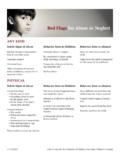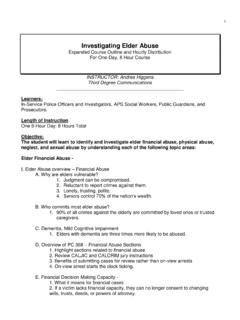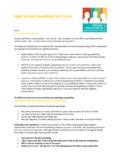Transcription of Child Abuse - - RN.org®
1 Child Abuse Reviewed February, 2018, Expires February, 2020 Provider Information and Specifics available on our Website Unauthorized Distribution Prohibited 2018 , , , LLC Developed by Wanda Lockwood, RN, BA, MA Purpose The purpose of this course is to describe the incidence of Child Abuse in the United States, the different types of Abuse , clinical and behavioral manifestations, and reporting requirements. Goals Upon completion of this course, one should be able to describe: A brief history of Child Abuse . The incidence of Abuse and the most prevalent types of Abuse . The 4 primary types of Child Abuse . Clinical manifestations of physical Abuse . Clinical manifestations of sexual Abuse . The 4 different types of neglect . Behavioral manifestations of Abuse . Shaken baby/shaken impact syndrome and Munchausen syndrome by proxy (MSP). Introduction For much of history, children were considered property of their parents, and there was little or no protection from Abuse provided by the law.
2 One of the earliest recorded cases of intervention in Child Abuse occurred in 1874 when the Society for the Prevention of Cruelty to Animals (SPCA) intervened in the case of Mary-Ellen Wilson, who at age 9 was found shackled to a bed, malnourished, and scarred from repeated beatings. She was discovered by a church worker, Mrs. Wheeler, who reported the Abuse to the authorities, who refused to intervene because the Child was property of the parents and there were no laws against Abuse . However, there WERE laws against the Abuse of animals, so Mrs. Wheeler appealed to the SPCA on the grounds that human beings were part of the animal kingdom. The SPCA intervened, and the Child was removed from the home. As a result of this case, the Society for the Prevention of Cruelty to Children was formed in 1874. However, it wasn t until a study based on radiographic evidence of multiple fractures, The Battered Child Syndrome, was published in 1962 that there was increased public awareness of physical Abuse .
3 Sexual Abuse was made public in the 1970 s and emotional Abuse in the 1980s. The federal government, responding to the increased awareness of Abuse , passed The Federal Child Abuse Prevention and Treatment Act (CAPTA) in 1974, and it has been amended a number of times, including the Keeping Children and Families Safe Act of 2003. While state laws may vary somewhat, CAPTA provides basic definitions of Child Abuse that the states use as minimum standards, and the government provides funding to the states to combat Child Abuse (5, 6, 7). CAPTA defines Abuse as: Any recent act or failure to act on the part of a parent or caretaker which results in death, serious physical or emotional harm, sexual Abuse or exploitation; OR An act or failure to act [that] presents an imminent risk of serious harm. Most states/territories recognize 4 types of Abuse : neglect , physical, sexual, and emotional.
4 Since 1988, the US Department of Health and Human Services has collected national data from the states, the District of Columbia, and Puerto Rico, through the National Child Abuse and neglect Data System (NCANDS). What is the incidence of Child Abuse in the United States? Despite the trend toward a national decrease in other crimes, the number of children referred to protective service agencies for Child Abuse has continued to increase. Whether this is because of an actual increase in Abuse or simply more effective identification of Abuse is not clear, but the statistics are grim. In 2006, approximately 905,000 children were mistreated ( : 1000). Girls suffer Abuse at a rate slightly higher than that of boys (boys, and girls ) and the highest rates of Abuse are for the youngest children, those under 1 year. USDHHS, Administration for Children & Families Each state s laws may vary slightly in relation to what is considered a criminal offense, but there are 4 primary types of Child Abuse : Physical Abuse .
5 Sexual Abuse . Emotional Abuse neglect . neglect , which is the broadest category of Abuse , is by far the most common type of Child Abuse , accounting for about two-thirds of the cases (2006 data): Category Number Percentage neglect 567,787 Physical Abuse 142,041 Medical neglect 19,180 Sexual Abuse 78,120 Psychological Abuse 58,577 Other Abuse 133,978 Unknown type Abuse 10,221 TOTAL: 1,009,004 Note: This figures exceeds 100% because some children suffer more than one type of Abuse . Almost 80% of Child Abuse is perpetrated by parents, and another by relatives, so most intervention programs are focused on the family. Women ( ) commit more acts of Child Abuse than men ( ), possibly because women are more commonly the caregivers for children. There are some differences according to ethnicity as well: USDHHS, Administration for Children & Families While Abuse by caregivers and foster parents is often highlighted by the media, almost 83% of Child Abuse is perpetrated by a parent acting along or with others.
6 USDHHS, Administration for Children & Families In the United States in 2005, 1460 children died because of Abuse and neglect , and this figure rose to 1530 in 2006. Most fatalities occurred in children under 4 years of age. These fatalities were directly caused by one or both parents in with by the mother acting alone. One sad fact is that reporting Abuse does not always end the Abuse . In of the fatalities, the children had received family preservation services within the prior 5 years by Child protective agencies. In of the fatalities, the children had been removed from the home and placed in foster care and then returned to the parents within the prior 5 years. USDHHS, Administration for Children & Families What are the manifestations of Abuse ? Healthcare providers must always be alert to the possibility of Child Abuse . There are a number of red flags that may indicate Abuse : Physical evidence consistent with Abuse (such as multiple bruises and fractures).
7 Inconsistent or conflicting stories about the cause of injuries. Placing blame for injuries on siblings. Injuries not consistent with reported history (such as a spiral fracture of the arm from falling off of a bed). Presenting with complaints not associated with the obvious signs of Abuse (such as reporting an earache and not mentioning extensive burns). Inappropriate responses by Child and/or caregiver. Parents may not exhibit concern and may express anger at the Child for an injury rather than provide comfort. They may blame the Child for the injury. Injuries not consistent with developmental stage of Child (such as a 6-month old pulling a pan with boiling water off of the stove). Child s report of Abuse or history of previous Abuse . Numerous visits to emergency departments with injuries. In some cases, all children in a family may be abused, but in others, parents may single out one Child for Abuse because of the Child s temperament, gender, physical needs, or various other reasons related to family dynamics.
8 However, even if only one Child is receiving the Abuse , simply removing THAT Child from the home does not ensure the safety of the others as the Abuse may be transferred to the other children. There have been many studies attempting to profile potential abusers, but the studies are not always consistent in their findings. Some parents who experienced Abuse as a Child will become abusers, but others become loving parents. However, those who experienced severe Abuse are more likely to Abuse their children. Abusive parents are often socially isolated with little support and may suffer from low self-esteem. Environmental stresses, such as poverty, divorce, and substance Abuse can contribute to Child Abuse ; however, Child Abuse occurs in all economic strata. Sometimes, people with more wealth are better able to conceal Abuse . Physical Abuse Physical Abuse occurs when someone inflicts injury, other than accidental, to a Child or when a person allows someone else to afflict this injury.
9 Physical Abuse can include shaking, beating, kicking, punching and burning. This can include shaken baby injuries. Corporeal punishment, which is unfortunately still common, should not leave bruises as this is an indication of beating, not discipline. Manifestations that could indicate Abuse include a number of different types of physical injuries and behavioral changes. Bruising/welts Children often have scattered bruises, especially on the legs, from normal childhood activities, but bruising on the face, lips, trunk, buttocks, and thighs especially large bruises are less common from ordinary falls and childhood injuries. Welts, such as from a belt or clothes hanger, are almost always related to Abuse . Pinch marks are also suggestive of Abuse . Bruises related to Abuse may range in color from yellow to purple, suggesting injuries at different times. Cupping (equal-sized circular bruises about the back) and coin rubbing (streaking bruises beside spinal column and along ribs), cultural practices that leave particular patterns of bruises, must be differentiated from Child Abuse .
10 Additionally, excessive bruising may relate to bleeding disorders, so this must be ruled out. Burning Accidental burning injuries usually show splash type asymmetric injuries while intentional injuries often have a more symmetric appearance with glove-like or sock-like injuries common from the Child s hand or foot being placed in scalding water. Round burns, from cigarettes or cigars, may be found. Common areas for intentional burns are on the soles of feet, palms, face, back, or buttocks. Stun gun injuries leave characteristic paired lesions that are about in diameter and about 5 cm apart. However, children may be stunned multiple times. Fractures and dislocations Children engaging in sports may fracture a wrist or ankle, but falls from normal play usually don t cause fractures. Typical fractures related to physical Abuse include skull, nose, or other facial fractures.
















